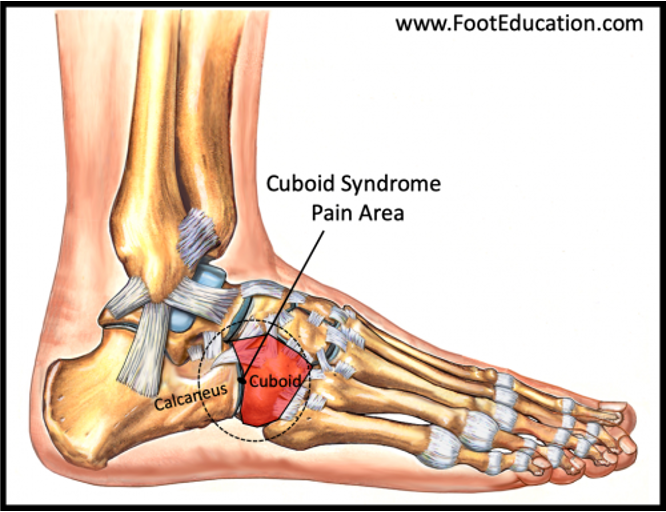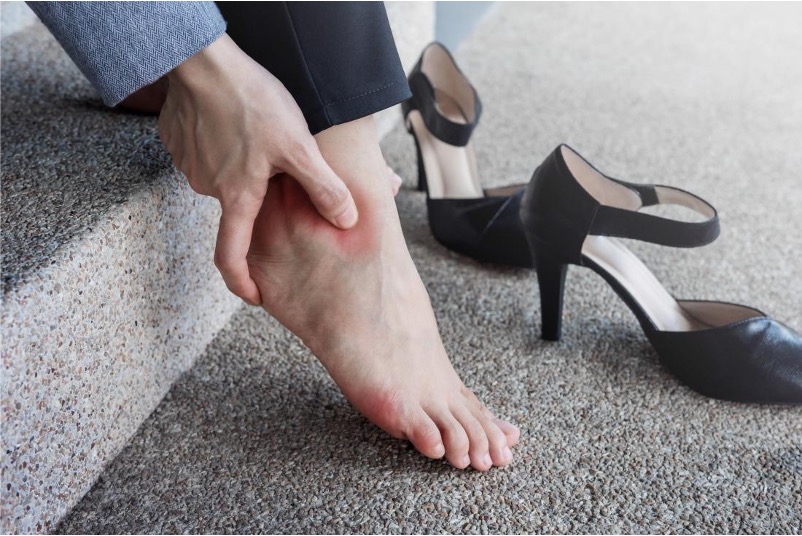Cuboid Pain: Symptoms, Causes, Recovery Treatment
:format(webp)/cdn.mskdoctors.com/storage/2025/3/h6ISpvCoJG8K6t8wc1Ek3tlBmlWkAcXB.jpg)
Key Takeaways
-
Cuboid pain is often caused by injuries or repetitive strain on the foot.
-
Symptoms include sharp pain on the outer side of the foot, which can worsen with weight-bearing activities.
-
Rest, ice, and elevation are immediate remedies to alleviate cuboid pain.
-
Physical therapy and proper footwear can aid in recovery and prevention.
-
Consulting with healthcare professionals like MSK Doctors can ensure effective treatment.
Understanding Cuboid Syndrome

Cuboid syndrome can be the result of sudden trauma or repetitive strain. (Image courtesy of FootEducation)
Cuboid syndrome occurs when the joint and ligaments surrounding the cuboid bone become injured or misaligned. This can happen due to sudden trauma, such as twisting your ankle, or from repetitive strain over time.
Cuboid syndrome causes discomfort or sharp pain on the outer side of your foot, making it difficult to walk or stand. The pain might feel more intense when you put weight on your foot, and you may notice swelling or tenderness around the affected area. Recognising the symptoms early is essential for effective treatment.
|
Identifying Symptoms
Pain Characteristics
The pain associated with cuboid syndrome can vary in intensity. For some, it might be a dull ache, while others may experience a sharp, stabbing sensation. You have to pay attention to when the pain occurs - as this can provide valuable insights into the underlying cause. For instance, if the pain worsens during physical activities, it might be related to overuse or strain.
In addition to pain, you might notice other symptoms like swelling or bruising around the cuboid bone. These signs can indicate inflammation or injury to the surrounding ligaments, requiring prompt attention to prevent further damage.
Additional Indications
Other indications of cuboid syndrome include difficulty moving your foot or a sensation of instability when walking. You might also hear a clicking or popping sound when moving your foot, which can be unsettling but is often associated with joint misalignment.
It's vital to differentiate these symptoms from other foot conditions, such as stress fractures, which can present similar signs.
Main Causes
Foot Injuries
One of the most common causes of cuboid pain is acute foot injuries, such as sprains or fractures. These injuries can occur during sports activities or accidents, leading to misalignment or damage to the cuboid bone. When the foot undergoes sudden trauma, the ligaments around the cuboid can stretch or tear - resulting in pain and instability.
Repetitive strain from activities like running or jumping can also lead to cuboid syndrome. Over time, the continuous stress on the foot can weaken the ligaments - making them more susceptible to injury.
Daily Activities
Daily activities, especially those that involve prolonged standing or walking on uneven surfaces, can also contribute to cuboid pain. Wearing inappropriate footwear that lacks proper support can exacerbate the condition, as it places additional strain on the foot's ligaments and joints.
Most importantly, maintaining proper foot alignment and using supportive footwear can help mitigate the risk of developing cuboid syndrome. Paying attention to your daily activities and making necessary adjustments can go a long way in preventing foot pain.
Associated Conditions
Certain medical conditions can increase the likelihood of experiencing cuboid pain. For instance, individuals with flat feet or high arches are more prone to developing this condition due to the uneven distribution of weight on the foot. In addition, conditions like arthritis or osteoporosis can weaken the bones and joints, making them more vulnerable to injury.
Therefore, if you have a pre-existing condition that affects your foot's structure or strength, take preventive measures and seek regular medical check-ups to monitor your foot health.
Recovery Treatments
Rest and Care
Resting your foot is crucial in the initial stages of cuboid pain recovery—giving your foot a break from activities that exacerbate the pain allows the injured ligaments and joints to heal. Elevating your foot and applying ice packs can help reduce swelling and inflammation.
The RICE method—Rest, Ice, Compression, and Elevation—is a simple yet effective approach to managing cuboid pain. Wrap your foot with an elastic bandage to provide support and reduce swelling. Elevate your foot above heart level when resting to enhance blood circulation and reduce inflammation.
Physical Therapy Techniques
Working with a physical therapist can help you regain strength and flexibility in your foot. Therapists often use manual manipulation techniques to realign the cuboid bone and relieve pressure on the surrounding ligaments.
Stretching and strengthening exercises like towel stretches and toe curls are an important part of physical therapy. Exercises that focus on the muscles and tendons around the cuboid bone can improve stability and prevent future injuries.
Natural Remedies
Natural remedies can complement your recovery process and help you regain mobility. Essential oils like peppermint or eucalyptus have anti-inflammatory properties that can help soothe foot pain. Try massaging the affected area with diluted essential oils for relief and relaxation.

Some essential oils can reduce foot pain.
Herbal supplements such as turmeric or ginger, known for their anti-inflammatory benefits, can be incorporated into your diet to reduce pain and swelling. Consuming these supplements in moderation can enhance your body's natural healing process.
Prevention Strategies
Proper Footwear
Wearing the right footwear is vital in preventing cuboid pain. Shoes that provide adequate support and cushioning can help distribute weight evenly across your foot, reducing pressure on the cuboid bone.

High heels can exacerbate foot pain.
Avoid high heels or shoes with insufficient arch support, as they can exacerbate foot pain. Opt for shoes with a wide toe box and a sturdy sole to enhance stability and comfort. Custom orthotic inserts can also provide additional support and correct any foot alignment issues, preventing further strain on the cuboid bone.
Exercise Recommendations
Low-impact exercises like swimming, cycling, or yoga can improve your foot's strength and flexibility without putting excessive strain on the joints.
Incorporating balance exercises into your routine will enhance your foot's stability and reduce the risk of falls or missteps that could lead to cuboid pain. Simple exercises like standing on one foot or using a balance board can significantly improve your foot's coordination and strength.
Foot Pain Cured The MSK Doctors Way
At MSK Doctors, we’ll ensure you receive the most effective treatment for cuboid pain. With our advanced diagnostic tools and techniques, we can accurately diagnose cuboid syndrome and differentiate it from other foot conditions. We offer targeted physical therapy programs to address specific needs and enhance recovery.
Our expert team provides guidance on lifestyle adjustments and preventive measures to maintain foot health. We employ a comprehensive approach, combining clinical expertise with a compassionate understanding of your unique situation, ensuring you receive the best possible care.

By collaborating with us, you can gain confidence in your treatment plan and feel supported throughout your recovery journey.
If you're experiencing cuboid pain, take the first step towards recovery by booking your consultation with MSK Doctors today. Don't let cuboid pain hold you back from enjoying life to the fullest.
Frequently Asked Questions (FAQ)
What is the typical recovery time for cuboid pain?
Recovery time for cuboid pain varies depending on the severity of the condition and the treatment approach. Generally, mild cases may resolve within a few weeks with proper rest and care.
How can I differentiate between cuboid syndrome and other foot pain?
Cuboid syndrome is characterised by sharp pain on the outer side of the foot, often exacerbated by weight-bearing activities. Other foot conditions, like plantar fasciitis, usually cause pain in different areas, such as the heel or arch.
Are there specific exercises to relieve cuboid pain?
Yes, certain exercises can help relieve cuboid pain by strengthening the surrounding muscles and improving flexibility. Toe curls, ankle circles, and calf stretches are common exercises recommended by physical therapists.
When should I see a doctor for cuboid pain?
If you experience persistent or worsening foot pain that affects your daily activities, it's important to seek medical attention. Early intervention can prevent complications and facilitate a quicker recovery.
How do MSK Doctors approach cuboid syndrome?
At MSK Doctors, we take a comprehensive approach to treating cuboid syndrome, combining clinical expertise with personalised care. Our team conducts thorough assessments to accurately diagnose the condition and develop individualised treatment plans.
:format(webp)/cdn.mskdoctors.com/storage/2025/5/hgH74n2NLXbN2EROC3N45aTdfUh1xKkM.jpg)
:format(webp)/cdn.mskdoctors.com/storage/2025/5/qf6zY2JVctL0BGJLEryU4lLIeRBsr5fC.jpg)
:format(webp)/cdn.mskdoctors.com/storage/2025/5/J26J2SuguZTzYNmqcI1EFk6a2wJsUF4a.jpg)
